
Paintings in Proust (Vol. 1, Swann’s Way)
November 14th, 2013, marked 100 years since Marcel Proust published Du côté de chez Swann (Swann's Way), the first volume of A la recherche du temps perdu, his masterwork written from 1909 to 1922, largely at night in the silence of a cork-lined room. Throughout the seven volume long searching tour through his memories - in his attempts to describe scenes and emotions, to help elucidate a point, sharpen an image, or as simply a subject in itself - Proust would time and again turn to the visual arts. As Proust says in the novel, “It is only through art that we can escape from ourselves and know how another person sees a universe which is not the same as our own and whose landscapes would otherwise have remained as unknown as any there may be on the moon.” He mentions more than a hundred painters from the 14th through the 20th century making, as the artist Eric Karpeles points out, “one of the most profoundly visual works in Western literature.” As a celebration of the centennial we have put together a few highlights of Proust's many mentions of artworks to be found in the first volume, Swann's Way, in which the narrator recounts his experiences growing up, participating in society, falling in love, and learning about art. The translations are from C.K. Scott Moncrieff's English translation (available here on project Gutenberg, in the public domain). We are indebted also to the excellent Paintings in Proust by Eric Karpeles, for helping us greatly in identifying the various mentions of artworks - a highly recommended book.
Giotto's Charity, Envy and Justice
 Scroll through the whole page to download all images before printing.
Scroll through the whole page to download all images before printing.Giotto's Charity, Envy, and Justice frescoes (1304-6) - Source.
In the year in which we ate such quantities of asparagus, the kitchen-maid whose duty it was to dress them was a poor sickly creature, some way 'gone' in pregnancy when we arrived at Combray for Easter, and it was indeed surprising that Françoise allowed her to run so many errands in the town and to do so much work in the house, for she was beginning to find a difficulty in bearing before her the mysterious casket, fuller and larger every day, whose splendid outline could be detected through the folds of her ample smocks. These last recalled the cloaks in which Giotto shrouds some of the allegorical figures in his paintings, of which M. Swann had given me photographs. He it was who pointed out the resemblance, and when he inquired after the kitchen-maid he would say: "Well, how goes it with Giotto's Charity?" And indeed the poor girl, whose pregnancy had swelled and stoutened every part of her, even to her face, and the vertical, squared outlines of her cheeks, did distinctly suggest those virgins, so strong and mannish as to seem matrons rather, in whom the Virtues are personified in the Arena Chapel. And I can see now that those Virtues and Vices of Padua resembled her in another respect as well. For just as the figure of this girl had been enlarged by the additional symbol which she carried in her body, without appearing to understand what it meant, without any rendering in her facial expression of all its beauty and spiritual significance, but carried as if it were an ordinary and rather heavy burden, so it is without any apparent suspicion of what she is about that the powerfully built housewife who is portrayed in the Arena beneath the label 'Caritas,' and a reproduction of whose portrait hung upon the wall of my schoolroom at Combray, incarnates that virtue, for it seems impossible, that any thought of charity can ever have found expression in her vulgar and energetic face. By a fine stroke of the painter's invention she is tumbling all the treasures of the earth at her feet, but exactly as if she were treading grapes in a wine-press to extract their juice, or, still more, as if she had climbed on a heap of sacks to raise herself higher; and she is holding out her flaming heart to God, or shall we say 'handing' it to Him, exactly as a cook might hand up a corkscrew through the skylight of her underground kitchen to some one who had called down to ask her for it from the ground-level above.
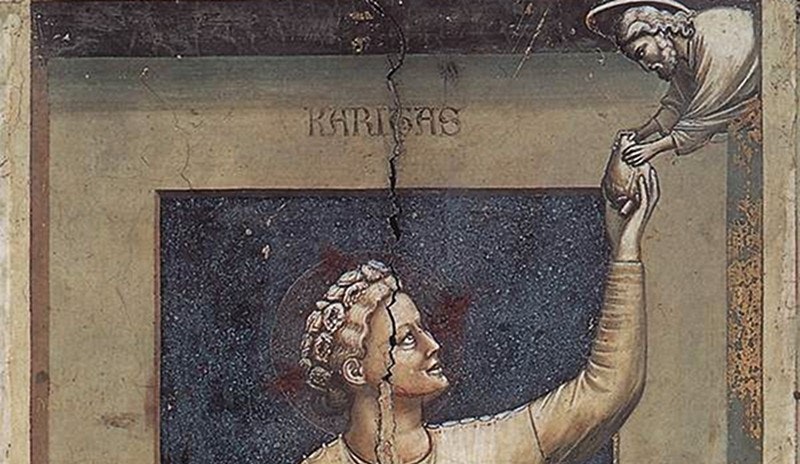 Scroll through the whole page to download all images before printing.
Scroll through the whole page to download all images before printing.The 'Invidia,' again, should have had some look on her face of envy. But in this fresco, too, the symbol occupies so large a place and is represented with such realism; the serpent hissing between the lips of Envy is so huge, and so completely fills her wide-opened mouth that the muscles of her face are strained and contorted, like a child's who is filling a balloon with his breath, and that Envy, and we ourselves for that matter, when we look at her, since all her attention and ours are concentrated on the action of her lips, have no time, almost, to spare for envious thoughts.
 Scroll through the whole page to download all images before printing.
Scroll through the whole page to download all images before printing.Despite all the admiration that M. Swann might profess for these figures of Giotto, it was a long time before I could find any pleasure in seeing in our schoolroom (where the copies he had brought me were hung) that Charity devoid of charity, that Envy who looked like nothing so much as a plate in some medical book, illustrating the compression of the glottis or uvula by a tumour in the tongue, or by the introduction of the operator's instrument, a Justice whose greyish and meanly regular features were the very same as those which adorned the faces of certain good and pious and slightly withered ladies of Combray whom I used to see at mass, many of whom had long been enrolled in the reserve forces of Injustice. But in later years I understood that the arresting strangeness, the special beauty of these frescoes lay in the great part played in each of them by its symbols, while the fact that these were depicted, not as symbols (for the thought symbolised was nowhere expressed), but as real things, actually felt or materially handled, added something more precise and more literal to their meaning, something more concrete and more striking to the lesson they imparted. And even in the case of the poor kitchen-maid, was not our attention incessantly drawn to her belly by the load which filled it; and in the same way, again, are not the thoughts of men and women in the agony of death often turned towards the practical, painful, obscure, internal, intestinal aspect, towards that 'seamy side' of death which is, as it happens, the side that death actually presents to them and forces them to feel, a side which far more closely resembles a crushing burden, a difficulty in breathing, a destroying thirst, than the abstract idea to which we are accustomed to give the name of Death?
Charles Gleyre's Lost Illusions
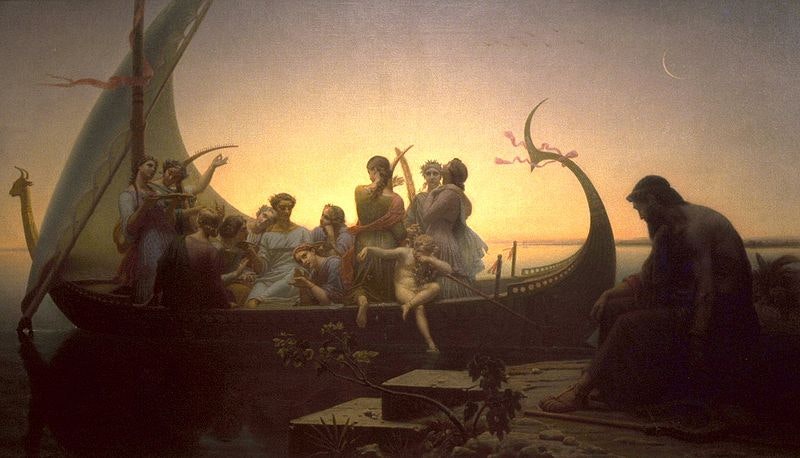 Scroll through the whole page to download all images before printing.
Scroll through the whole page to download all images before printing.Charles Gleyre's Lost Illusions (1843) - Source.
Sometimes in the afternoon sky a white moon would creep up like a little cloud, furtive, without display, suggesting an actress who does not have to 'come on' for a while, and so goes 'in front' in her ordinary clothes to watch the rest of the company for a moment, but keeps in the background, not wishing to attract attention to herself. I was glad to find her image reproduced in books and paintings, though these works of art were very different—at least in my earlier years, before Bloch had attuned my eyes and mind to more subtle harmonies—from those in which the moon seems fair to me to-day, but in which I should not have recognised her then. It might be, for instance, some novel by Saintine, some landscape by Gleyre, in which she is cut out sharply against the sky, in the form of a silver sickle, some work as unsophisticated and as incomplete as were, at that date, my own impressions, and which it enraged my grandmother's sisters to see me admire.
Pieter de Hooch's Interiors
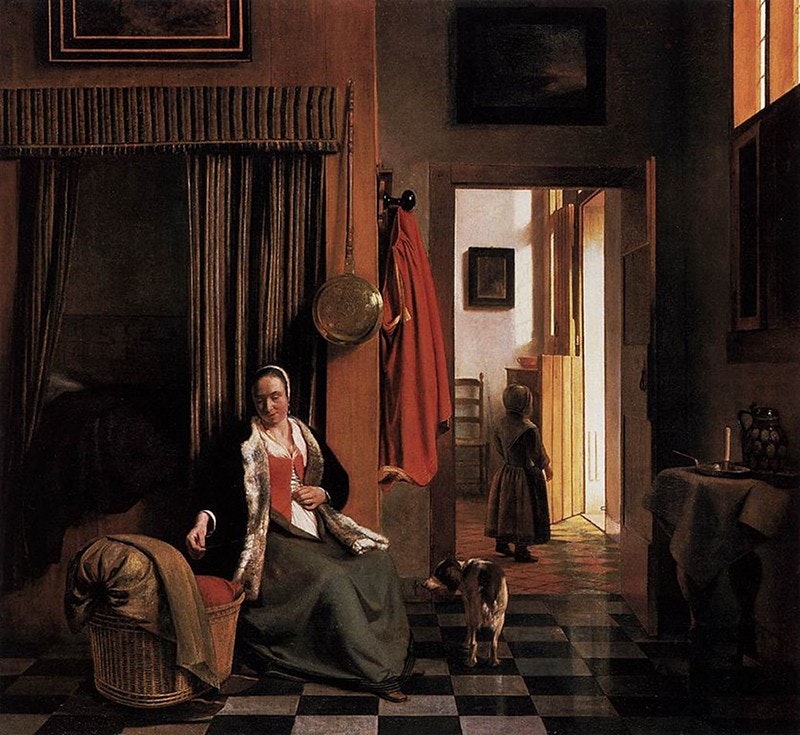 Scroll through the whole page to download all images before printing.
Scroll through the whole page to download all images before printing.Pieter de Hooch's Mother Lacing Her Bodice beside a Cradle (1670) - Source.
He would enter the drawing-room; and there, while Mme. Verdurin, pointing to the roses which he had sent her that morning, said: "I am furious with you!" and sent him to the place kept for him, by the side of Odette, the pianist would play to them—for their two selves, and for no one else—that little phrase by Vinteuil which was, so to speak, the national anthem of their love. He began, always, with a sustained tremolo from the violin part, which, for several bars, was unaccompanied, and filled all the foreground; until suddenly it seemed to be drawn aside, and—just as in those interiors by Pieter de Hooch, where the subject is set back a long way through the narrow framework of a half-opened door—infinitely remote, in colour quite different, velvety with the radiance of some intervening light, the little phrase appeared, dancing, pastoral, interpolated, episodic, belonging to another world.
Sandro Boticelli's Trial of Moses
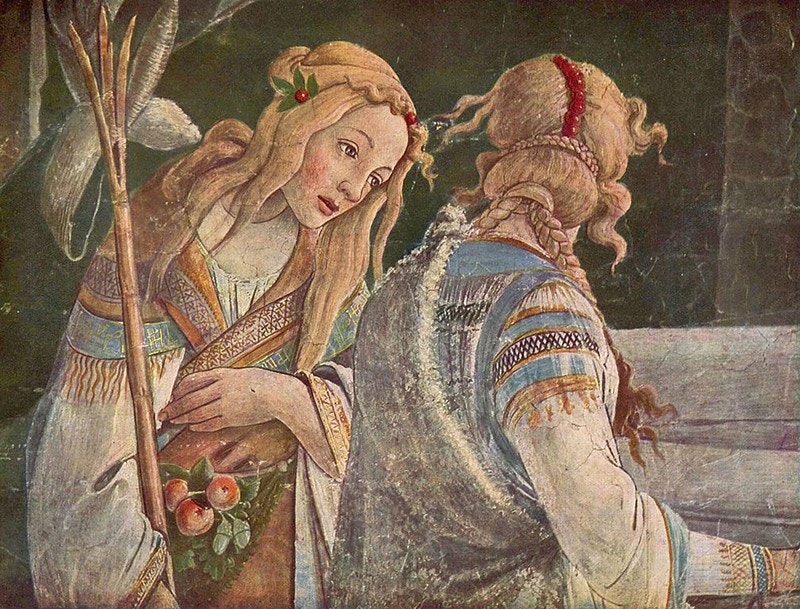 Scroll through the whole page to download all images before printing.
Scroll through the whole page to download all images before printing.Detail from Sandro Boticelli's Trial of Moses showing Jethro's daughter Zipporah - Source.
He stood gazing at her; traces of the old fresco were apparent in her face and limbs, and these he tried incessantly, afterwards, to recapture, both when he was with Odette, and when he was only thinking of her in her absence; and, albeit his admiration for the Florentine masterpiece was probably based upon his discovery that it had been reproduced in her, the similarity enhanced her beauty also, and rendered her more precious in his sight. Swann reproached himself with his failure, hitherto, to estimate at her true worth a creature whom the great Sandro would have adored, and counted himself fortunate that his pleasure in the contemplation of Odette found a justification in his own system of aesthetic. He told himself that, in choosing the thought of Odette as the inspiration of his dreams of ideal happiness, he was not, as he had until then supposed, falling back, merely, upon an expedient of doubtful and certainly inadequate value, since she contained in herself what satisfied the utmost refinement of his taste in art. He failed to observe that this quality would not naturally avail to bring Odette into the category of women whom he found desirable, simply because his desires had always run counter to his aesthetic taste. The words 'Florentine painting' were invaluable to Swann. They enabled him (gave him, as it were, a legal title) to introduce the image of Odette into a world of dreams and fancies which, until then, she had been debarred from entering, and where she assumed a new and nobler form. And whereas the mere sight of her in the flesh, by perpetually reviving his misgivings as to the quality of her face, her figure, the whole of her beauty, used to cool the ardour of his love, those misgivings were swept away and that love confirmed now that he could re-erect his estimate of her on the sure foundations of his aesthetic principles; while the kiss, the bodily surrender which would have seemed natural and but moderately attractive, had they been granted him by a creature of somewhat withered flesh and sluggish blood, coming, as now they came, to crown his adoration of a masterpiece in a gallery, must, it seemed, prove as exquisite as they would be supernatural.
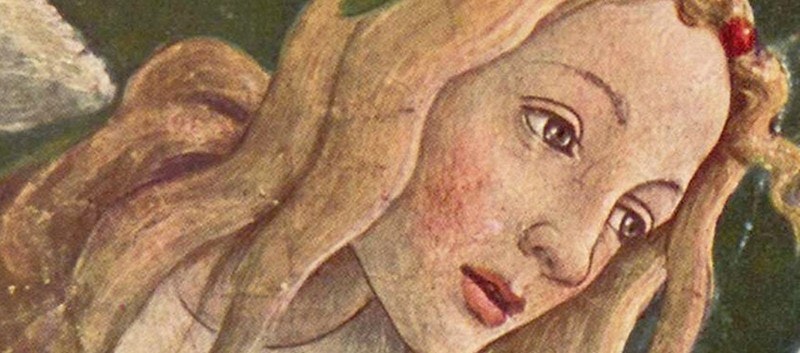 Scroll through the whole page to download all images before printing.
Scroll through the whole page to download all images before printing.And when he was tempted to regret that, for months past, he had done nothing but visit Odette, he would assure himself that he was not unreasonable in giving up much of his time to the study of an inestimably precious work of art, cast for once in a new, a different, an especially charming metal, in an unmatched exemplar which he would contemplate at one moment with the humble, spiritual, disinterested mind of an artist, at another with the pride, the selfishness, the sensual thrill of a collector.
On his study table, at which he worked, he had placed, as it were a photograph of Odette, a reproduction of Jethro's Daughter. He would gaze in admiration at the large eyes, the delicate features in which the imperfection of her skin might be surmised, the marvellous locks of hair that fell along her tired cheeks; and, adapting what he had already felt to be beautiful, on aesthetic grounds, to the idea of a living woman, he converted it into a series of physical merits which he congratulated himself on finding assembled in the person of one whom he might, ultimately, possess. The vague feeling of sympathy which attracts a spectator to a work of art, now that he knew the type, in warm flesh and blood, of Jethro's Daughter, became a desire which more than compensated, thenceforward, for that with which Odette's physical charms had at first failed to inspire him. When he had sat for a long time gazing at the Botticelli, he would think of his own living Botticelli, who seemed all the lovelier in contrast, and as he drew towards him the photograph of Zipporah he would imagine that he was holding Odette against his heart....
Or else she would look at him sulkily, and he would see once again a face worthy to figure in Botticelli's 'Life of Moses,' he would place it there, giving to Odette's neck the necessary inclination; and when he had finished her portrait in distemper, in the fifteenth century, on the wall of the Sixtine, the idea that she was, none the less, in the room with him still, by the piano, at that very moment, ready to be kissed and won, the idea of her material existence, of her being alive, would sweep over him with so violent an intoxication that, with eyes starting from his head and jaws that parted as though to devour her, he would fling himself upon this Botticelli maiden and kiss and bite her cheeks.
Giotto's Panels
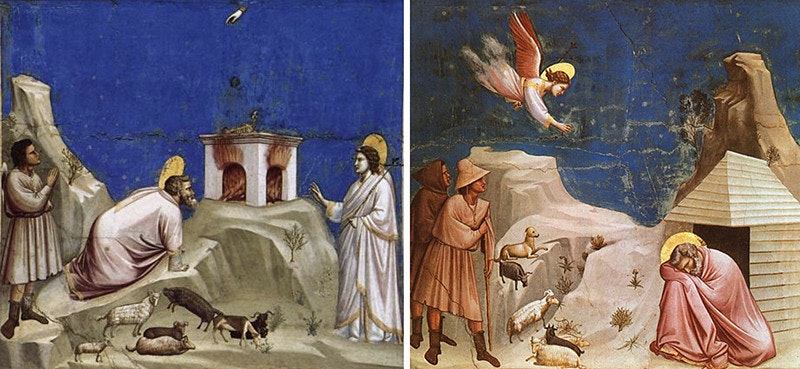 Scroll through the whole page to download all images before printing.
Scroll through the whole page to download all images before printing.Giotto's The Sacrifice of Joachim and The Dream of Joachim (1304-6) - Source.
When my father had decided, one year, that we should go for the Easter holidays to Florence and Venice, not finding room to introduce into the name of Florence the elements that ordinarily constitute a town, I was obliged to let a supernatural city emerge from the impregnation by certain vernal scenes of what I supposed to be, in its essentials, the genius of Giotto. All the more—and because one cannot make a name extend much further in time than in space—like some of Giotto's paintings themselves which shew us at two separate moments the same person engaged in different actions, here lying on his bed, there just about to mount his horse, the name of Florence was divided into two compartments. In one, beneath an architectural dais, I gazed upon a fresco over which was partly drawn a curtain of morning sunlight, dusty, aslant, and gradually spreading; in the other (for, since I thought of names not as an inaccessible ideal but as a real and enveloping substance into which I was about to plunge, the life not yet lived, the life intact and pure which I enclosed in them, gave to the most material pleasures, to the simplest scenes, the same attraction that they have in the works of the Primitives), I moved swiftly—so as to arrive, as soon as might be, at the table that was spread for me, with fruit and a flask of Chianti—across a Ponte Vecchio heaped with jonquils, narcissi and anemones. That (for all that I was still in Paris) was what I saw, and not what was actually round about me. Even from the simplest, the most realistic point of view, the countries for which we long occupy, at any given moment, a far larger place in our true life than the country in which we may happen to be. Doubtless, if, at that time, I had paid more attention to what was in my mind when I pronounced the words "going to Florence, to Parma, to Pisa, to Venice," I should have realised that what I saw was in no sense a town, but something as different from anything that I knew, something as delicious as might be for a human race whose whole existence had passed in a series of late winter afternoons, that inconceivable marvel, a morning in spring.
Nicolas Poussin's Spring, or the Earthly Paradise
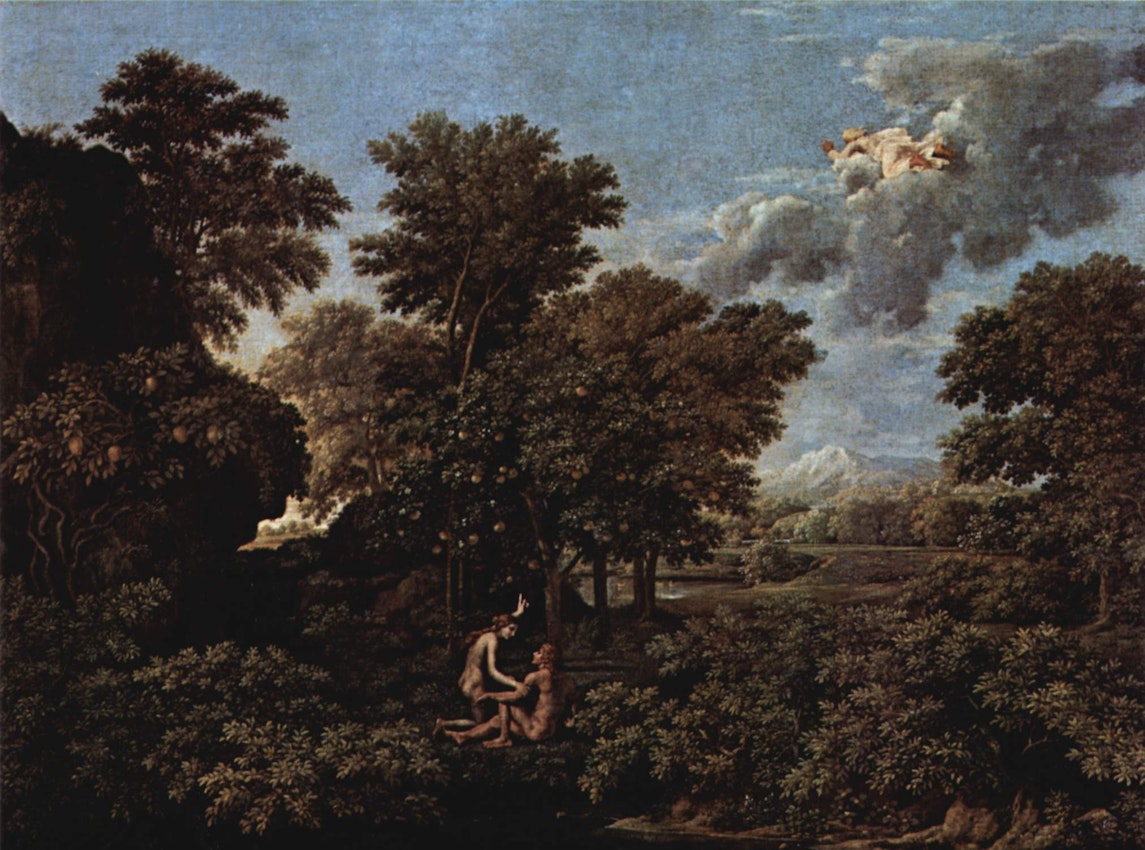 Scroll through the whole page to download all images before printing.
Scroll through the whole page to download all images before printing.Nicolas Poussin's Spring, or the Earthly Paradise (1660) - Source.
The name Gilberte passed close by me, evoking all the more forcibly her whom it labelled in that it did not merely refer to her, as one speaks of a man in his absence, but was directly addressed to her; it passed thus close by me, in action, so to speak, with a force that increased with the curve of its trajectory and as it drew near to its target;—carrying in its wake, I could feel, the knowledge, the impression of her to whom it was addressed that belonged not to me but to the friend who called to her, everything that, while she uttered the words, she more or less vividly reviewed, possessed in her memory, of their daily intimacy, of the visits that they paid to each other, of that unknown existence which was all the more inaccessible, all the more painful to me from being, conversely, so familiar, so tractable to this happy girl who let her message brush past me without my being able to penetrate its surface, who flung it on the air with a light-hearted cry: letting float in the atmosphere the delicious attar which that message had distilled, by touching them with precision, from certain invisible points in Mlle. Swann's life, from the evening to come, as it would be, after dinner, at her home,—forming, on its celestial passage through the midst of the children and their nursemaids, a little cloud, exquisitely coloured, like the cloud that, curling over one of Poussin's gardens, reflects minutely, like a cloud in the opera, teeming with chariots and horses, some apparition of the life of the gods; casting, finally, on that ragged grass, at the spot on which she stood (at once a scrap of withered lawn and a moment in the afternoon of the fair player, who continued to beat up and catch her shuttlecock until a governess, with a blue feather in her hat, had called her away) a marvellous little band of light, of the colour of heliotrope, spread over the lawn like a carpet on which I could not tire of treading to and fro with lingering feet, nostalgic and profane, while Françoise shouted: "Come on, button up your coat, look, and let's get away!" and I remarked for the first time how common her speech was, and that she had, alas, no blue feather in her hat.
Nov 14, 2013








